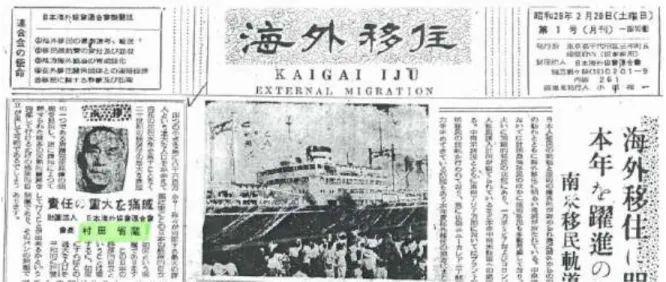Bridging the gap : japanese overseas migration and Japan´s national history
Texto completo
(2)
(3) Documentos de Trabajo en Estudios Asiáticos. Pontificia Universidad Católica de Chile (UC) Facultad de Historia, Geografía y Ciencia Política Programa de Estudios Asiáticos Av. Vicuña Mackenna 4860 Macul, Santiago de Chile. Contacto por correo electrónico: jrehner@uc.cl (Johannes Rehner) Página web: http://www.uc.cl/icp/webcp/estudiosasiaticos/. Los resultados y opiniones presentados en el documento son de exclusiva responsabilidad de su autor y no expresan necesariamente la visión del Programa de Estudios Asiáticos de la Pontificia Universidad Católica de Chile (UC) ni de su Comité Editorial. El autor también es responsable de la originalidad del trabajo presentado. Para publicar en los Documentos de Trabajo en Estudios Asiáticos de la UC consulte la página web indicada.. Comité Editorial: Roberto Durán. Miembro CEA UC; Profesor del Instituto de Ciencia Política UC Marcos Jaramillo. Director del Centro de Estudios Asiáticos UC, profesor de la Facultad de Derecho UC Johannes Rehner. Miembro CEA UC; Profesor del Instituto de Geografía UC Raimundo Soto. Miembro CEA UC; Profesor del Instituto de Economía UC. 3.
(4) Bridging the gap: Japanese overseas migration and Japan’s national history 12. Pedro Iacobelli. 1. Working Paper based on a talk given in the Japan Institute of the Australian National University on 26 July 2013. 2 Working Paper, not for citation or quotation without author´s permission.. 4.
(5) P. Iacobelli. 5. Japanese overseas migration. 1. Abstract ............................................................................................................. 6. 2. Introducing the Japanese colonies in Bolivia ....................................................... 6. 3. “Sense of Crisis” and the early discussion on migration ..................................... 10. 4. The uses of Migration ....................................................................................... 13. 5. Expansion of State’s apparatuses and the Bolivian case .................................... 15. 6. Conclusions ...................................................................................................... 19. 7. Bibliografía ....................................................................................................... 19.
(6) P. Iacobelli. Japanese overseas migration. 1 Abstract This Working Paper analyses Japanese outmigration from the point of view of the sending state. It starts from the case of post-war Japanese migration to Bolivia and in doing so, this paper joins the recent scholarship that challenges the disciplinary separation found in the postwar history of Japan: between the Japanese overseas migration and Japan’s national history. The question that this working paper examines is to what extent the post-war Japanese migrants in Bolivia reveal mainland Japan’s historical contingencies? This article advances some key elements of the concept “political migration history”—a framework for the study of state-led emigration policies—in order to argue that the outmigration’s policy making process reveals the deep transformations that the Japanese society was experiencing as a whole and thus, the Japanese national history benefits from a political history reading of this migratory process.. 2 Introducing the Japanese colonies in Bolivia In 1954 two ships, carrying about 400 Okinawan migrants, embarked at the port of Naha with direction to the port of Santos in Brazil. The route crossed the Indian and Atlantic Oceans in a one-month and a half journey. From Santos, they continued by train their trip to the city of Santa Cruz, Bolivia. In the latter part of the journey, the migrants traversed the states of Sao Paulo and Mato Grosso do Sul. Once they arrived in Santa Cruz, they were officially welcomed by Bolivian authorities and then transported to their final destination in a two-day trip on trucks. Their journey lasted in total two months. The following year, a group of mainland Japanese migrants did a similar trip, arriving in San Juan de Yapacaní in the Santa Cruz region. Two Japanese agricultural settlements (colonias), one from Okinawa 6.
(7) P. Iacobelli. Japanese overseas migration. and the other from mainland Japan, were set less than a hundred kilometers apart in the same region of Bolivia (see Figure 1). More migrants came to each colony every year until late 1960s. In total, over six thousand Japanese and Okinawan people migrated to Santa Cruz Department under one of the state-sponsored program. After extremely difficult first decades filled with harshness and despair, both colonies managed to put together two relatively successful agricultural colonies. The San Juan colony became an important producer of macadamia nuts and the Okinawan colony (“Colonia Okinawa”) grew to become a small district in the department of Santa Cruz—a recognizable “dot” on the Bolivian map. Indeed, the noodle production in the Okinawa colony is one of the biggest in the country, with TV commercials showing the “high quality of Okinawan men-made noodles.” These TV commercials (that can be seen in YouTube) display the hybridity of “Japan in Bolivia”, the outcome of a long-term policies promoting immigration into South America3. The commercials, accompanied by traditional sanshin music, evoke the strong Okinawan cultural elements within the broader and bigger Japanese community in Santa Cruz. For the Bolivian viewer the distinction between the Japanese settlement in Yapacaní and the Ryukyuan in “Okinawa” presents no ethnic differences and yet, within the Japanese and Okinawan communities the historical contingencies that forced the establishment of two parallel migration programs are still alive in early twenty-first century. Even though the establishment of these two colonies followed very different paths, the official narratives of post-war Japan’s migration history randomly pay attention to the distinctions between both groups. Indeed, Okinawa prefecture was part of the newly acquired territories by Japan in the second half of the nineteenth century. A former independent kingdom with its own language and culture, the Ryūkyū Islands were forcefully annexed to the growing Empire in 1879. Since then, the mainland Japanese government put forward a strong assimilation policy (nihonnka, dōka), dominating the economic, political and cultural life in Okinawa. Okinawan people were taught to venerate the Japanese emperor, forbidden. 3. 7. http://www.youtube.com/watch?v=cH5jbsL5Ah0 [Accessed on 16 Abril 2015].
(8) P. Iacobelli. Japanese overseas migration. from using their own language in public and had their traditions and customs banned (Kerr, 1958). When the Pacific War broke in 1941, Okinawa was transformed into a military base, the last Japanese bulwark against Allied fire. The Battle of Okinawa was the only one fought on Japanese soil, causing over two hundred thousand death, half of them were Okinawan civilians. The US-led occupation of Japan divided the territory: on one hand the four main islands of Japan—following the Potsdam declaration—were administered by the Allied powers; but Okinawa was exclusively occupied by the US military. When the mainland Japanese and Okinawan migrants’ settlement were established in Bolivia, the government in Tokyo had only recently, as we shall see below, became independent from foreign direct control. But Okinawa remained a US military stronghold. Therefore, each of these settlements in Santa Cruz can connect us to a very different historical context. Considering the seemly disconnected narratives between Japan´s national historiography and overseas migration accounts, and the little relevance that migration has played in the historiography on Japan, the question that this working paper examines is to what extent the post-war Japanese migrants in Bolivia reveal mainland Japan’s historical contingencies? In other words, what can these settlements tell us about the Japanese state and politics? Only by tackling these problems, it is possible to bridge Japan´s national history and its overseas communities.. 8.
(9) P. Iacobelli. Japanese overseas migration. Figure 1: Map of Santa Cruz, Bolivia. Source: Figure produced by the author and Australian National University CartoGIS CAP.. The literature on Japanese overseas communities has heavily focused on the colonies’ development and migrants’ personal experiences - This is particularly clear in the scholarship emerged from the Nikkei communities, for example (Kikumura-Yano, 2002). In addition, various authors have emphasized a diaspora narrative by putting together the experiences of two or more colonies in the Americas (White, 2003), (Yanaguida & Rodriguez del Alisal, 1992). Indeed, the government of Japan’s diplomatic missions and business investments in the region has strengthened the community of overseas Japanese in the Americas. However, the diaspora narrative tends to void the migrants from their historical and political meaning. Indeed, the diaspora or free migration narrative can obscure the power relations at work within those collective decisions. Authors like Azuma Eiichiro, Uchida Jun and Asano Toyomi have recently explored the connections between migration and the state, before and after the Pacific War. My study joins their efforts to bring the state back to the discussion about migration, and to contribute for the better understanding of the Japanese national history (Azuma, 2003), (Uchida, 2011). My approach to migration focuses predominantly on public policy (political migration history) rather than on the migrant´s agency. Hence, this work examines the political context and discussion from where emigration policies originated, the initial post-. 9.
(10) P. Iacobelli. Japanese overseas migration. war debate on migration, the uses that migration (the ways in which the state could benefit from it), and finally the mechanics of migration in the 1950s.. 3 “Sense of Crisis” and the early discussion on migration The Japanese imperialist campaign in Asia and the Pacific ended catastrophically in August 1945. The nation’s economy was in collapse; the main cities were devastated; and the population was psychologically in tatters (Dower, 1999). Shortly after, the repatriation of millions of overseas Japanese began. Even though repatriation was a two-ways process, since it also “repatriated” back to the continent roughly one million Koreans in 1946 alone, the dominant impression was that those returning were exacerbating the depressed economic situation (Watt, 2009). The Japanese authorities, greatly influenced by NeoMalthusian thinking, believed that the country was experiencing a severe case of overpopulation. The number of inhabitants, following the baby boom of the early post-war years, rose from seventy-one million people in 1945 to eighty-nine million people in 1955, an increase of eighteen millions in ten years (Boys). The perceived overpopulation problem was accompanied by a strong “sense of crisis” that required an immediate response.. 10.
(11) P. Iacobelli. Japanese overseas migration. Table 1: Post-war Japanese returnees by origin. Origin. No. of returnees (1945 – 1969. China. 1,534,863. Manchuria. 1,045,527. Southeast Asia. 711,506. South Korea. 596,934. Taiwan. 479,544. Soviet Union. 472,939. North Korea. 322,585. Kuriles. 293,478. Dalian. 225,955. Australia. 138,843. Ryukyu Other regions Total. 69,416 398,177 6,289,767. Source: The Ministry of Welfare, quoted in (Japan Emigration Service, 1972, pág. 19).. Simultaneously, the occupying authorities conducted a series of political reforms to turn Japan into a “democratic” and “demilitarized” country. These political reforms allowed the emergence of new or revived political and intellectual groups that were critical to the previous regime (Gluck, 1993). However, high level statesmen during the worst period of the war, such as Murata Shōzō, Aoki Kazuo, Shigemitsu Mamoru, and Kishi Nobosuke went back into politics and played important roles in the migration programs once their time at Sugamo Prison concluded4. The Japanese lawmakers began to discuss the overpopulation problem the same year the Diet was reinstalled under the new constitution in 1947. In a ruined country with a growing population, Diet members, influenced by the medical lobby group, decided to privilege pro-. 4. 11. Sugamo Prison was the main penitentiary institution hosting wartime criminals. It was located in Tokyo.
(12) P. Iacobelli. Japanese overseas migration. abortion policies as the main demographic-related policy to halt the expansion of the number of inhabitants. It should be noted that the Japanese birth control discussion was based on the Neo-Malthusian principle that reducing the population (or in this case slowing its growth) would help the economy to recover and thus increase the standard of living (Steiner, 1953). The Japanese lawmakers and the government also considered promoting international migration as a solution to the overpopulation problem. Although Japan was under occupation and had no direct control of its own borders, migration attracted growing interest in the media, and among scholars and policymakers. The first parliamentary initiative to include migration as a political measure against overpopulation came when the House of Representatives passed the May 13, 1949 ‘Resolution Pertaining to the Population Problem’ (人口問題に関する決議案) (House of Representatives, 1949.). Even though the focus lay on topics such as “the emancipation of women (婦人解放)” or Improvement of women’s culture (女性文化の向上)” the resolution mentioned the necessity to re-start migration programs. The Diet recommended in the Resolution that the government “shall prepare research and study [the feasibility of ] overseas migration in the future, and request assistance and cooperation from those to whom it may relate”. The reasons to do so were stated as follows: a) “[A] lifting of the ban on Japanese emigration in the future will not only be useful for improving the well-being of the nation’s people, but also will contribute greatly to post-war reconstruction in the world”. And b) “It is also an important way of expressing a sense of thankfulness to the world for allowing and satisfying the heartfelt wishes of our citizens.” The early discourse on migration stressed the sense of crisis among policy-makers and called to prepare overseas migration in the future. This, however, does not imply, as we see below, that Japanese politicians truly believed that international migration could solve the overpopulation problem by itself.. 12.
(13) P. Iacobelli. Japanese overseas migration. 4 The uses of Migration For the Japanese authorities the promotion of migration had a political function. It could, first, as put in the 1949´s resolution, “satisfy the heartfelt wishes of [the Japanese] citizens” for emigration; and second, it could contribute to the post-war reconstruction in the world. The local demand for international migration needs to be understood at two levels: First, from the point of view of the propelling forces at play in post-war Japan; and second, from the emigrants´ decision-making process. The propelling forces were the poor economic situation and the austerity plan in defeated Japan, physic collapse in the Japanese people after the war, the sense of overpopulation aggravated by the repatriation process and even the nuclear paranoia5. People from all over Japan, particularly from the southern prefectures applied for migration programs when they were made available. Few people had the economic means and connections to migrate (see Table 2), and thus, from a quantitative point of view, a migration program could not solve the problem of overpopulation by itself. Nevertheless, it could contribute to spread a specific discourse about the value of migration at home and overseas. At this point we can centralize the question on the State and ask about what was the State’s rationale behind promoting migration? Japan’s authorities considered emigration as an important tool to recover the nation’s economy as well as to reinsert Japan into the global economy. For Japan the ultimate goal in the international arena was to attain a seat in the UN. Previous steps included joining the GATT and the IMF (Kaoru, 2008). Labour export was identified as an important element for reducing unemployment, improving the balance of payment, securing skills and investment of capital. Indeed, the economic benefits obtained from promoting migration in a considered overpopulated nation were clearly stated in the 1949’s Resolution and repeated axiomatically by the Japanese authorities. Furthermore, emigration was seen as an opportunity to reinsert Japan in the global community. 5. State of despondency as explained by Dower, Embracing Defeat. p.83. The consequences of the austerity plan as explained by Eiji Takamae, p.469. And the nuclear paranoia as seen in Kurosawa;’s film ikimono no kioku (1954).. 13.
(14) P. Iacobelli. Japanese overseas migration. dominated by the United States. There was, thus, a close connection between local recovery and international cooperation. Table 2: Post-war Japanese migration by prefecture of origin, 1952-1960 Prefecture. Migrants. Hokkaido. 2,874. Fukushima. 2,364. Tokyo. 1,954. Wakayama. 1,714. Hiroshima. 1,509. Yamaguchi. 1,818. Ehime. 1,498. Kochi. 2,410. Fukuoka. 3,393. Nagasaki. 3,433. Kumamoto. 3,656. Kagoshima. 2,120. sub total. 28,743. Others. 13,277. Total. 42,020. Source: (JICA, pág. 260) 6.. The view of migrants as man-power to be invested overseas was widely used by the Japanese authorities in the early 1950s. Indeed, this view was commonly used by many international organizations. The International Labour Organization (I.L.O.), based in Geneva, was influential in the formation of a post-war Japanese discourse on migration. Particularly, the article “The I.L.O. Manpower Program” (I.L.O., 1949) published in the institutional journal “International Labour Review” in April 1949 had a great impact on the. 6. 14. JICA, "Kaigai Ijū Tokei (海外移住統計),"(JICA, 1994)..
(15) P. Iacobelli. Japanese overseas migration. Japanese policymakers 7. The new element brought by the I.L.O. was the recognition of migration as international cooperation. Migration, in the eyes of the I.L.O. and the Japanese authorities, was also a way to transfer human capital to lesser-developed areas, and as such to contribute to the world’s welfare. The Japanese government observed that there was a favorable reception to international migration within the international community. International migration was perceived as economically beneficial for the sending nation as well as for the “underpopulated” host country. International organizations such as the I.L.O. encouraged it, and there was funding available from American banks for migration projects. Consequently, the government of Japan considered migration not only as a way to satisfy people’s wishes for emigrating, but also as a means to contribute to the international community, attain international redress after the years of occupation and help with the nation’s economy solvency.. 5 Expansion of State’s apparatuses and the Bolivian case The government of Japan quickly began to re-structure its migration apparatus once the peace treaty was enforced and the SCAP and the U.S. military government were dissolved in 1952. In order to coordinate the work done onshore and to support the migrants offshore, the Japanese government established two agencies affiliated with the MOFA. The Kaikyōren (Federation of Overseas Associations, 日本海外協会連合会) was established “to handle the recruiting of emigrants, arranging for their acceptance, and lending emigrants the money for passage” in 1954 (MOFA, 1985). The Kaikyōren established offices in every prefecture and distributed pamphlets and “Guidelines of Recruitment” throughout the country to explain the emigration process and to select the migrants. The Kaikyōren was a fundamental piece in the post-war emigration puzzle created by the government of Japan.. 7. The Ministry of Public Welfare’s report on this article in the Jinkō Mondai Kennkyūsho, "Imin to Keizaikaihatsu (I.L.O No Imin Taisaku Shiryō)(Migrants and Economic Development [ a Document on the Migration Policy from I.L.O.])," ed. Ministry of Public Welfare (Tokyo1951).. 15.
(16) P. Iacobelli. Japanese overseas migration. In a way, it was the main filter to select migrants that could contribute to the country’s economy and international reinsertion. Its programs, while promoting migration for everyone (see Figure 2), sought to send skilled migrants (JICA, 1954). On the other hand, the Japan Emigration Promotion Co. Ltd. or JEP (est.1955) (海外移住振興株式会社) was responsible for the financial aspects of the emigration programs. It was responsible for purchasing and distributing land as well as for lending money for capital investment in the overseas colonies. The JEP provided loans to individual emigrants and companies who supported would-be emigrants. These two agencies, semi-independent from the government, merged into the Japan Emigration Service established in 1963 which expanded its services into Okinawa in 1967. Figure 2: The signpost for tomorrow’s road.. Source: Japan Emigration Service. Kaigai Ijū Jigyō Danjūnenshi (海外移住団十年史) Tokyo1972. It should be stressed that the role of private companies was severely reduced in the postwar emigration structure. From being the real engine of the migration programs by organizing, recruiting, funding and overseeing the migration in the pre-war years, they became a subsidiary player after 1952. There were a few exceptions when the State allowed private investors to play a more actively engaged role in the emigration program. In these cases, particularly before the establishment of the new emigration apparatus in. 16.
(17) P. Iacobelli. Japanese overseas migration. 1954/1955, some entrepreneurs were behind small movement of people towards their agricultural projects in South America. Nevertheless, their new role was to provide services for the emigration plan. The control of the emigration programs lay on the Japanese government. Japan’s state-endorsed emigration program sent migrants to several states in South America and the Caribbean8. In the Bolivian case, the Japanese government could meet the demand for emigration at home and collaborate, as required by the I.L.O., with the international system. In Bolivia, the Revolutionary Nationalist Movement (hereafter MNR), led by President Victor Paz Estenssoro, began an ambitious plan to colonize and develop the northeast region of Santa Cruz. The government of Bolivia, after an initial contact from the Japanese diplomatic office in Peru, followed the advice of the U.S. and the local Bolivian/Japanese community and negotiated an immigration program9. For the government of Japan the option of sending emigrants to Bolivia was very important10. First, Bolivia was one of the very few destinations available for Japanese migrants in the early 1950s. Japan, as former enemy, was still regarded suspiciously by its neighbors and thus banned from sending migrants. Moreover, the outbreak of the Cold War deepened the divisions between countries, particularly in Asia, and hindered the government of Japan from negotiating migration programs with most Communist nations. Second, Bolivia, as a non-pre-war destination, signified a fresh start for the Japanese state-led emigration. The Bolivian request for skilled immigrants was a good opportunity for Japan to exhibit global solidarity. The government of Japan articulated its emigration program to Bolivia in a two track path. While negotiating with the government of Bolivia a long term emigration agreement, they supported a Japanese entrepreneur to install his sugar refinery in Bolivia and bring. 8. Among the countries that received Japanese immigration after World War II were Dominican Republic, Brazil, Argentina and Peru 9 Bolivia supported the U.S. during World War Two by selling their tin and iron ore. 10 Japan also promoted migration to Brazil and other South American destinations (Argentina, Paraguay, etc). But while in Brazil there was already a big community, many Japanese people could migrate as “yobiyose” or invited migrants, rather than members of an organized and coordinated group. 17.
(18) P. Iacobelli. Japanese overseas migration. Japanese migrants as yobiyose (呼び寄せ), or called migrants. As a result, when the government of Japan finally signed an agreement with the government of Bolivia in 1956, Japanese migration had already begun. Kaikyōren and the JEP articulated migration since 1954/1955. This included recollecting information about Bolivia, creating their own material, promoting and selecting the migrants and installing offices in Bolivia to support the colonies. For example, they collected among other things, a 1953 study on the local Japanese population, a book describing Bolivia, Japanese translation of Bolivia’s 1926 immigration laws, translation of Bolivian law related to direct foreign investment and the distribution of utilities, the Civil Code, Penal Code, and finally a copy of Joaquin Roldana’s history of Santa Cruz. They created a series of manuals about life in Bolivia and reported regularly about Bolivia in the Kaikyōren’s journal “Kaigai Ijū” (see Figure 3). As a result, the landlocked country gained more “visibility” in Japan and migrants were better prepared. Figure 3: Kaikyōren’s journal “Kaigai Ijū”.. Source: Kaigai Ijū, 20 February 1954, Front Page. Document held in JICA’s archive, Yokohama.. 18.
(19) P. Iacobelli. Japanese overseas migration. 6 Conclusions We can observe a link between the Japanese overseas migration programs and internal dynamics of Japanese post-war national history. This connection uncovers patterns of change and continuity in the relationship between the State and emigration. Particularly, it shows how the State, by playing an active role in shaping migratory flows, intervened in the sending society. In this sense, the discussion about the “overpopulation problem” and the solutions put forward are part of the postwar nation-building process in Japan. The study of post-war state-led Japanese migration program to Bolivia shed light on both the socio-economic realities onshore but also on the global politic dynamics. The government of Japan saw in migration not only a subsidiary remedy for the overpopulate problem, but also a means to heighten its international status. Migration was a Japanese public policy and not the result of a free-migration movement. From this point of view the Japanese migrants in Bolivia became agents of Japan’s international policy. The success of the migration program to Bolivia was thus, connected to Japan’s reinsertion in the international community after the war.. 7 Bibliografía Azuma, E. (2003). The Politics of Transnational History Making Japanese Immigrants on the Western 'Frontier,' 1927-1941. The Journal of American History 89 (4) . Boys,. A.. F.. (s.f.).. Population. of. Japan. 1870-2100.. http://www9.ocn.ne.jp/~aslan/pfe/jpeak.htm. Dower, J. W. (1999). Embracing Defeat: Japan in the Wake of World War II. New York: W. W. Norton & Company, Inc.. 19.
(20) P. Iacobelli. Japanese overseas migration. Gluck, C. (1993). The Past in the Present. En A. G. (ed.), Postwar Japan as History. University of California Press: Berkeley. House of Representatives. (13 de May de 1949.). Jinkō Mondai Ni Kansuru Ketsugian (Resolution Pertaining to the Population Problem), Meet record # 27.,. I.L.O. (1949). The I.L.O. Manpower Programme. International Labour Review LIX, no. 4. Japan Emigration Service. (1972). Kaigai Ijū Jigyō Danjūnenshi (海外移住団十年史) (Ten Years of Japan Emigration Service). Tokyo. JICA. (20 de April de 1954). Kaigai ijū. pág. 4. JICA. (s.f.). Kaigai ijyu jigyoudann jyuunennshi (Ten Years of the Corporation for Emigration). Tokyo: 1972. Kaoru, K. (2008). Japan's Struggle for U.N. Membership in 1955. En e. a. Iokibe Makoto, Japanese Diplomacy in the 1950s: From Isolation to Integration. London: Routledge. Kikumura-Yano, A. (2002). Encyclopedia of Japanese Descendants in the Americas. New York: AltaMira Press. MOFA. (1985). MOFA Bluebook. Steiner, J. F. (1953). Japan's Post-War Population Problems . Social Forces 31 (31). Uchida, J. (2011). Brokers of Empire : Japanese Settler Colonialism in Korea, 1876 - 1945. Cambridge, Mass.: Harvard University Asian Center. Watt, L. (2009). When Empire Comes Home. Cambridge: Harvard University Press. White, P. (2003). The Japanese in Latin America: On the Uses of Diaspora. International Journal of Population Geography 9. Yanaguida, T., & Rodriguez del Alisal, M. D. (1992). Japoneses En América. Madrid: Mapfre.. 20.
(21)
Figure
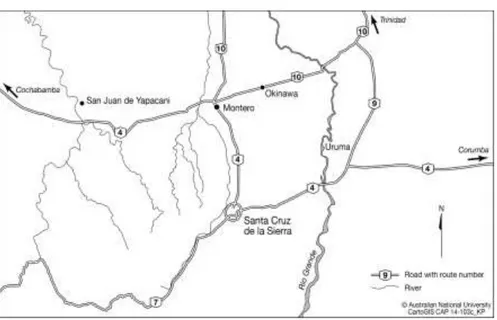
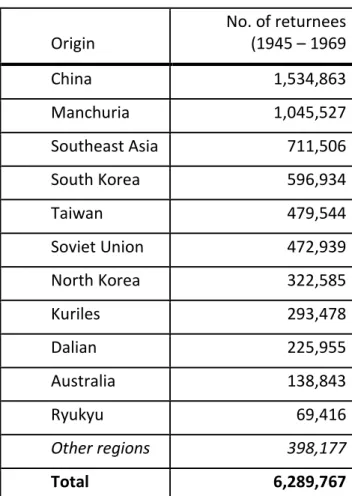
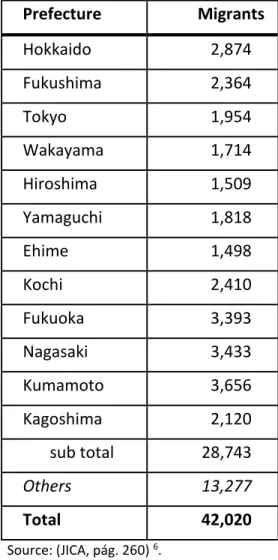
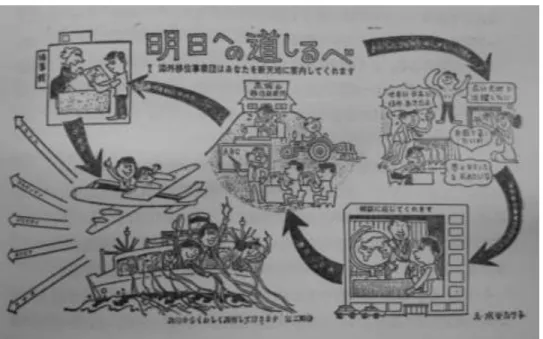
Documento similar
MD simulations in this and previous work has allowed us to propose a relation between the nature of the interactions at the interface and the observed properties of nanofluids:
The Global Compact for Safe, Orderly and Regular Migration (Global Compact for Migration hereinafter) has been considered the first instrument to comprehensively address all
After the Spanish withdrawal from the territory in 1975, Morocco waged a brutal military campaign against the Polisario, and large numbers of people fled to refugee camps, where
13 GEORGI, Fabian, “For the Benefit of Some: The International Organization for Migration and its Global Migration Management”, en GEIGER, Martin y PéCOUD, Antoine (dir.),
[68], this mechanism might prefer the boron migration to the hydride migration (Scheme 11)... suggested that the catalytic cycle for the hydroboration of vinylarenes follows the
Given an accretion rate, and assuming a type I migration rate, one can compute the amount of migration a planet suffers while growing to a gap opening mass.. In thin discs
In the previous sections we have shown how astronomical alignments and solar hierophanies – with a common interest in the solstices − were substantiated in the
The concept of breakdown probability profile is useful to describe the break- down properties of any estimate obtained through resampling, not just the bagged median or the
